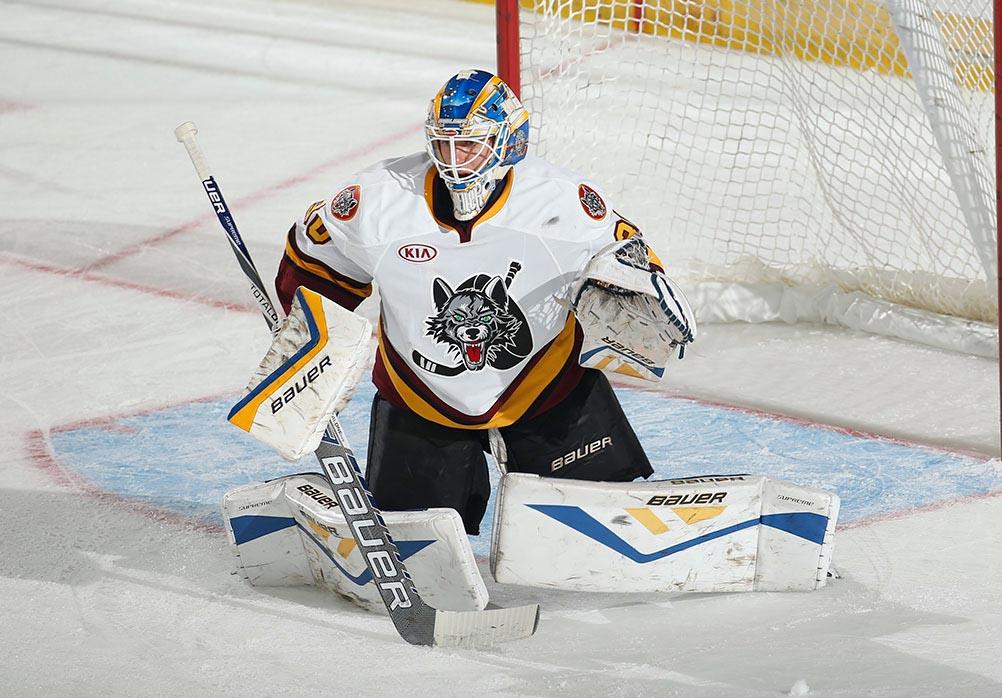by Lindsey Willhite | AHL On The Beat Archive
Professional hockey players are not asked to file “What I Did This Summer” essays when they report for the new season. Their careers don’t depend on their writing skills. Penmanship doesn’t win championships.
But Chicago Wolves goaltender Jordan Binnington might volunteer to jot down his offseason exploits on paper, if only to have the most productive summer of his life chronicled for posterity.
What I Did This Summer
I wanted to do everything in my power to improve my craft, so here are some of the things I accomplished:
– I learned to wiggle my big toe without moving my other toes. I increased my flexibility to the point where I can stretch my femur (the bone that connects the hip and the knee) behind my derriere. Both of these things improved my balance, power and agility in goal.
– I moved in with a friend and his family and learned a ton about nutrition. Thanks to everything I learned, I will no longer refer to myself as a boring chef and I will eat better more consistently.
– I participated in the week-long Biosteel camp in Toronto where they held a four-team draft prior to the games. I was a first-round pick along with NHL wunderkind Connor McDavid, seven-year NHL veteran Chris Stewart and rising goaltender Malcolm Subban.
“This was definitely the most knowledge-filled summer for me,” Binnington said. “Honestly, it’s been a process of learning how to be a pro. It’s taking care of yourself and your routine. What I realized this summer is that it’s a full-time job. You go to the gym. There’s homework that I do right when I wake up and when I go to bed. There’s meditation and stuff like that. You’ve got to be disciplined.”
To understand why the 22-year-old from Richmond Hill, Ontario, spent his offseason this way, perhaps it’s best to review how he wrapped up his first season with the Wolves:
In the Utica Comets’ visitors dressing room, the goaltenders’ cubicles are located in a corner hidden from much of the rest of the team’s view.
That’s where Binnington could be found — arms crossed in his lap and head bowed toward the floor — for a long time on May 2 after Utica edged the Wolves during the deciding Game 5 of last season’s Western Conference Quarterfinal playoff series.
Binnington slumped in his corner and struggled to resolve conflicting feelings. Like the other Wolves in the room, he came away bitterly disappointed they couldn’t finish off the top-seeded Comets. At the same time, he sensed he crossed into a new realm with his Calder Cup Playoffs performance.
Binnington played every second of the series and allowed just 12 goals in 333-plus minutes. His sterling .938 save percentage and 2.16 goals-against average soundly eclipsed his regular-season numbers — and he delivered while playing under significant pressure against a team that went all the way to the Calder Cup Finals.
“We were working together as a team and we were battling,” Binnington said. “That’s what a playoffs is about. I was kind of upset that the excitement stopped.
“Saying that, I feel like I gained a lot of experience and realized I could feel good and give the team a chance to win in a playoff game. It was good for me, but I still think we could have won that series. It’s pretty frustrating. I guess you’ve just got to learn and keep learning as you develop more.”
Binnington returned home to Toronto and gave himself nearly a month to decompress. He visited Las Vegas for the first time. He visited his family’s cottage in Muskoka several times. Mostly, though, he thought about what it would take to build on his playoff performance. He consulted with multiple trainers, including Wolves strength and conditioning coach Evan Levy.
At 6-foot-1 and just 170 pounds, he knew he needed to add muscle. But he also wanted to become more flexible. And become better technically in goal. And ensure he maintained his improvements with proper nutritional and stretching habits. But how to accomplish all of these things at the same time – and do it properly?
That’s when Binnington’s friend, Grant Holliday, entered the picture and provided a template for making all of it happen.
Binnington and the 25-year-old Holliday met at the Fitness 4 Success gym in Vaughn, Ontario, a few years ago. Holliday trained Binnington there, then both eventually found their way to the Stackhouse Performance gym in Toronto. That’s where they resumed their friendship as well as their mentor/trainee relationship this summer.
If Binnington wanted somebody to help him focus his training, he couldn’t have found better. Holliday quit hockey at 16, went to college and used his 6-7, 270-pound frame to transform into one of Canada’s leading young discus throwers. Then, abruptly in August 2014, he decided to stop throwing the discus and devote himself around the clock to becoming a hockey player again — one painstaking step at a time.
Holliday taught himself to skate properly. Then he taught himself to shoot properly. All the while, he maintained impeccable eating and training habits. He dropped 35 pounds and saw his body fat percentage melt from 24 percent to 9. After a year’s worth of dedication, he has earned a chance to tryout for the ECHL.
“I never go out and say I do more than anyone else,” Holliday said. “I just know I found a formula that makes me do as much as I physically and mentally can do.”
That’s what Binnington wanted to do, too. One Friday night in June, they were trading texts and Binnington suggested that he should move in with Holliday and his parents in Toronto in order to immerse himself in this lifestyle. Before the weekend ended, he was moved in and the transformation was underway.
“Let’s say you have a workout and a skate on a day and it’s a total of two or three hours,” Holliday said. “You’ve still got 21 or 22 hours left in the day. That can absolutely make or break your return on investment of that workout and that skate you did.”
When Binnington woke up in the morning, he did his “homework” that involved stretching. Before he went to bed, he’d do more stretching homework to activate his glutes and his abdomen muscles. Throughout the day, he and Holliday planned well ahead for every meal. In the morning, they determined what they’d ingest for their post-workout nutrition. In the evening, they figured out what food they needed for the next day’s breakfast. They even spent time on the mental aspects of the game and ensuring positive thoughts crowd out negative ones.
Holliday’s overall goal for Binnington? Help him build a keystone habit as described by The Power of Habit author Charles Duhigg.
“It doesn’t happen overnight,” Holliday said. “But definitely this summer, ‘Binner’ has shown some really good fire. Any habit, it’s always one step at a time. He’s committed. If you change that one keystone habit, then it’s a chain reaction. Binner’s keystone habit this summer has been ironing out the nutrition.”
Binnington considered himself a “50 percent” healthy eater last season, but wants to reach 100 percent this season. And when he cooks healthy meals for himself, he doesn’t plan to stick to plain ground turkey and chicken. Holliday and his mother gave him a plethora of recipes that feature vegetables and spices and other things to keep him from hating and discarding his healthy keystone habit.
Binnington understands the weight of this journey that he began this summer, but cannot wait to see where it takes him. That’s why he doesn’t list this season’s goals in terms of wins or goals-against average or save percentage, though he started the 2015-16 season well as he allowed just one goal in Chicago’s 5-1 victory over the Milwaukee Admirals on Saturday night.
“Just continue to improve. Every day,” he said. “Master this taking-care-of-yourself thing away from the rink. Figuring out what works for me and what I need to do to feel good. Everybody’s body is different, everybody’s mind is different.
“I’ve got to figure out what works to compete at the highest level. You want to be the best all-around person and obviously, for me, the best goaltender you can be.”






































